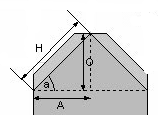
When drawing CCD objects with sloping elements, calculation of the actual distances required to ensure accurate drawing of such elements such that the resultant model’s component pieces marry properly. The easiest way to calculate the values necessary to do this is to make use of either trigonometry, or the rules described by Pythagoras.
For any given required slope, imagine the slope as the hypotenuse of a right-angled triangle:

• The length of the hypotenuse (H) of the triangle
• The angle formed by the base of the triangle, and the slope of the hypotenuse (a)
• The length of the side adjacent to that angle (A)
• The length of the side opposite that angle (O)
• The angle between the opposite and the hypotenuse (b)
If the two known elements are sides (H, A, or O), and the required element is the length of the third side, it is a simple matter to apply Pythagoras to calculate the value needed.
If the two known elements include an angle, or the required element is an angle, then we must use trigonometry to calculate the value needed.
Note that, if a or b is known, it is a simple matter to calculate the remaining angle. The angles contained within a triangle will always add up to 180°, and, since one of the angles in a right angled triangle will always be known (the right angle itself, which is 90° by definition), the following formula may be re-arranged as necessary to calculate the required angle:
a+b=90°
There are three basic trigonometric functions, these being Sine (sin), Cosine (cos), and Tangent (tan). It is unnecessary, within the scope of CCD, to discuss the how’s and why’s of these functions - any good calculator will provide buttons to calculate sine, cosine, and tangent for any given angle, and to derive an angle if given that angle’s sine, cosine, or tangent, such that:
• To calculate the sine, cosine, or tangent of an angle, enter the value of the angle into your calculator, then press the "sin", "cos", or "tan" button as required.
• To calculate an angle based upon its sine, cosine, or tangent, enter the value of the sine, cosine, or tangent, press the inverse or shift key on your calculator, and press "sin-1", "cos-1", or "tan-1" button as required.
Thus, "sin 45°" refers to the value of the sine of 45°, and "sin-1 0.70711" refers to the angle that possesses a sine value of 0.70711 (which happens to be 45°).
The trigonometric functions, angles, and sides interact using the following formula:
Sin (a)=O/H
Cos (a)=A/H
Tan (a)=O/A
Similarly:
Sin (b)=A/H
Cos (b)=O/H
Tan (b)=A/O
And in written terms:
The sine of an angle is equal to the length of the side opposite it, divided by the length of the hypotenuse
The cosine of an angle is equal to the length of the side adjacent to it, divided by the length of the hypotenuse
The tangent of an angle is equal to the length of the side opposite it, divided by the length of the side adjacent to it
The formulae may be re-arranged as necessary in order to gain the desired value. For example:
O=sin (a)×H
H=O/sin (a)
Armed with these functions, even the most complex dioramas objects become relatively easy to calculate.
Related Topics: